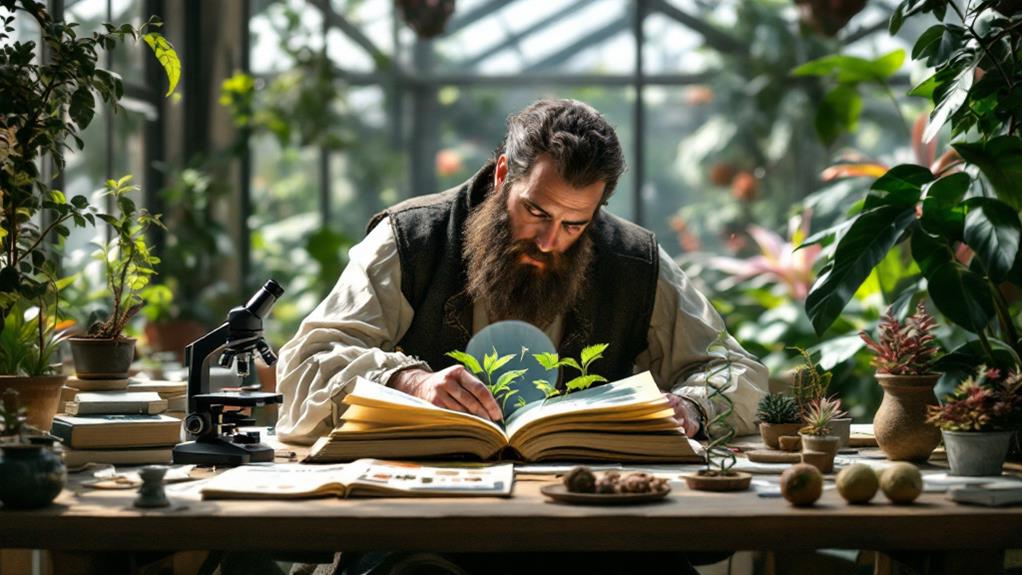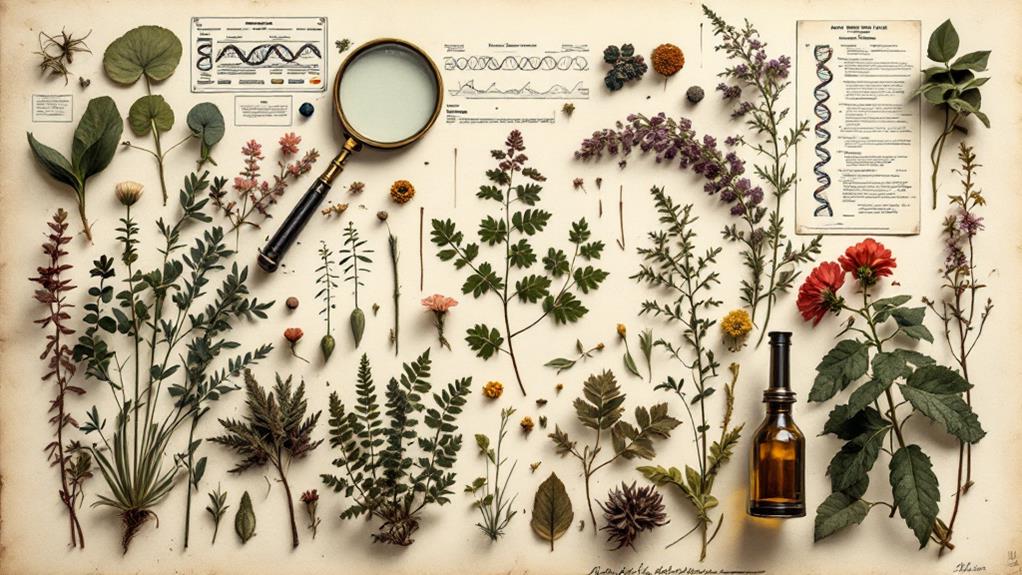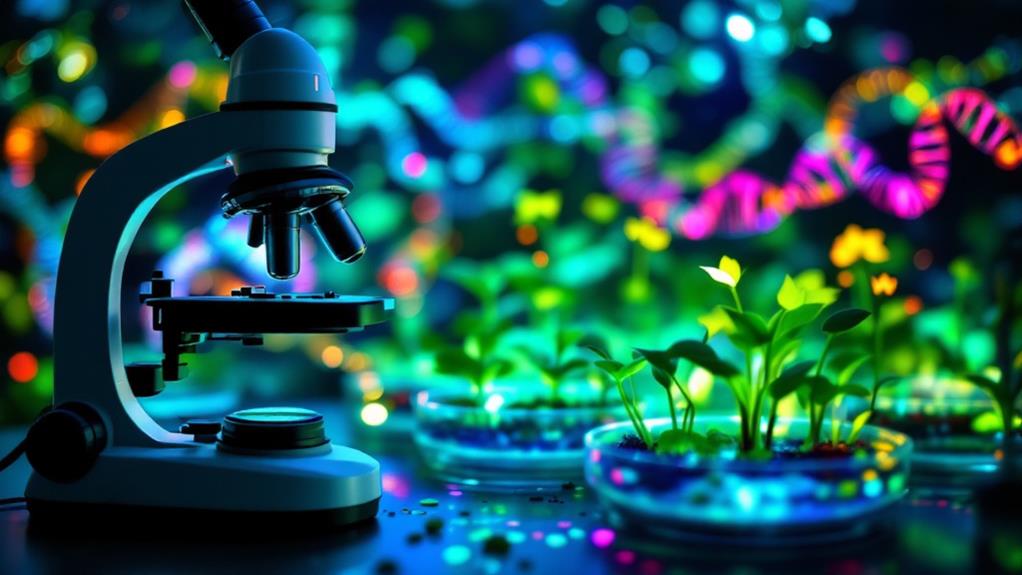The History of Botany: How Plant Science Has Evolved Over the Centuries

Botany's plunge spans millennia, from ancient civilizations' plant studies to today's bleeding-edge genetic research. You'll find its roots in early herbal medicine and systematic classifications by Greek philosophers. The Renaissance brought botanical gardens and global plant exploration, while Linnaeus revolutionized taxonomy in the 18th century. Darwin's evolution theory transformed understanding of plant diversity. Microscopes unveiled cellular structures, and genetics opened new frontiers in plant breeding. Modern botany tackles global challenges like food security and climate change. From medicinal herbs to GMOs, plant science has shaped human history and continues to impact our future. Uncover how this green science branches into every aspect of life.
Ancient Roots of Plant Knowledge
Countless ancient civilizations laid the groundwork for our modern understanding of botany. You'll find that early humans began observing and documenting plant life as far back as 3500 BCE. These early botanists weren't just curious; they were driven by necessity. They needed to identify which plants were edible, which could heal, and which might harm them.
Ancient Egyptians, Greeks, and Chinese were particularly advanced in their botanical knowledge. They developed sophisticated medicinal plant uses, creating remedies for various ailments. You'd be surprised to learn that many of these ancient treatments are still used today.
Ancient agricultural practices also played an essential role in the development of botany. As civilizations grew, so did their need for reliable food sources. They began selectively breeding plants, developing irrigation systems, and studying crop rotation. These practices laid the foundation for modern agriculture and plant science.
The works of early botanists like Theophrastus, often called the "Father of Botany," and Dioscorides, who wrote the influential "De Materia Medica," continue to influence our understanding of plants today. Their systematic approach to classifying and describing plants paved the way for future scientific advancements in the field.
Renaissance and Botanical Exploration
As the Renaissance dawned in Europe, botanical investigation underwent a stunning metamorphosis. You'd see a shift from the medieval botanical gardens, primarily focused on medicinal plants, to a broader interest in exotic species from newly discovered lands. This period marked a significant leap in herbal medicine development, as explorers brought back unknown plants with potential healing properties.
You'd witness the emergence of detailed botanical illustrations and the first attempts at systematic plant classification. Herbalists and physicians began compiling extensive catalogs of plants, detailing their characteristics and potential uses. These works laid the foundation for modern botany.
The Age of Exploration opened up new horizons for plant enthusiasts. You'd find European botanists eagerly accompanying voyages to the Americas, Asia, and Africa, collecting specimens and documenting unfamiliar flora. This influx of new plant knowledge challenged existing theories and spurred further scientific inquiry.
Universities started establishing dedicated botanical gardens for research and education. You'd observe a growing interest in plant anatomy and physiology, as scholars began to investigate the mysteries of plant life cycles and structures.
Taxonomy and Classification Systems

The quest to organize the vast array of plant life led to the development of taxonomy and classification systems. You'll find that early attempts at plant classification schemes were often based on practical uses or simple physical characteristics. However, as botanical knowledge expanded, more sophisticated systems emerged.
In the 18th century, Carl Linnaeus revolutionized botanical nomenclature with his binomial system. He introduced the practice of using two Latin names to identify each species, providing a standardized approach that's still used today. Linnaeus also developed a sexual system of classification, grouping plants based on their reproductive parts.
As you investigate further, you'll uncover that subsequent botanists built upon Linnaeus' work. They created more complex classification schemes that considered evolutionary relationships and genetic similarities. The advent of molecular biology in the 20th century brought about significant changes in plant taxonomy. DNA analysis allowed for more accurate groupings and led to the development of the APG (Angiosperm Phylogeny Group) system, which continues to evolve as our understanding of plant relationships deepens.
Cell Theory and Plant Anatomy
While classification systems organized plants externally, botanists also sought to understand their internal structures. The development of cell theory in the 19th century revolutionized plant science. You'll find that this theory, proposed by Matthias Schleiden and Theodor Schwann, established cells as the fundamental units of life.
As microscopes improved, botanists could observe plant cell structures in greater detail. They uncovered organelles like chloroplasts, responsible for photosynthesis, and the rigid cell wall that gives plants their structure. The study of cell division processes, including mitosis and meiosis, shed light on plant growth and reproduction.
Plant anatomy became an indispensable field, revealing how different tissues work together. You'd be amazed at the complexity of vascular systems, with xylem transporting water and phloem carrying nutrients. Botanists also explored the structure of leaves, roots, and stems, uncovering adaptations that allow plants to thrive in diverse environments.
This deeper understanding of plant anatomy and cellular processes has paved the way for modern botanical research, including genetic studies and biotechnology applications. It's transformed our comprehension of plant life and continues to drive innovation in agriculture and environmental science.
Genetics and Molecular Botany

Genetics and molecular botany ushered in a fresh chapter of plant science in the 20th century. As you delve into this era, you'll discover how scientists unraveled the mysteries of plant DNA and gene expression. The discovery of DNA's structure in 1953 by Watson and Crick opened new avenues for understanding plant genetics.
You'll find that researchers began to investigate plant metabolism at the molecular level, uncovering the intricate biochemical pathways that drive photosynthesis and other vital processes. They've also made significant strides in comprehending cellular signaling in plants, revealing how these organisms respond to environmental stimuli and regulate their growth.
Advancements in genetic engineering have allowed scientists to modify plants for improved crop yields, disease resistance, and nutritional content. You'll see how techniques like gene editing and CRISPR-Cas9 have revolutionized plant breeding and biotechnology. These tools have enabled researchers to study gene function more precisely and create plants with desired traits more efficiently than ever before. As you explore this field, you'll appreciate how molecular botany has transformed our understanding of plant life and its potential applications.
Modern Applications of Plant Science
Building on the foundations of genetics and molecular botany, modern plant science has blossomed into a field with far-reaching applications. You'll find its impact in various sectors, from agriculture to environmental conservation.
In sustainable agriculture, plant scientists develop crops with enhanced nutritional value, disease resistance, and drought tolerance. These innovations help increase food security and reduce the need for harmful pesticides. You can see the results in your local grocery store, where you might find vitamin-enriched rice or blight-resistant potatoes.
Environmental remediation is another area where plant science shines. Researchers use plants to clean up contaminated soil and water through a process called phytoremediation. You might encounter these "green cleaners" in urban brownfields or near industrial sites, quietly removing toxins from the environment.
Plant science also contributes to renewable energy production, with advances in biofuels derived from algae and other plant sources. As you fill up your car, you might be using fuel partially created through botanical research.
From improving crop yields to cleaning the environment, modern plant science continues to shape the world around you in countless ways.



